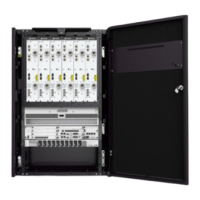
 Loading...
Loading...
Do you have a question about the Huawei U-SYS MRS6100 and is the answer not in the manual?
| Category | Server |
|---|---|
| Model | U-SYS MRS6100 |
| Processor | Intel Xeon E5-2600 series |
| Memory | DDR4 |
| Storage | SSD |
| Power Supply | Redundant power supplies |
| Operating System | Windows Server, Linux |
Details about the MRS6100 Media Resource Server V100R002.
Explains the structure and arrangement of the manual's content.
Identifies the target readers for this technical manual.
Describes formatting and notation used throughout the document.
Outlines the core functions and value-added media services provided by the MRS6100.
Illustrates the MRS6100's integration within the NGN architecture.
Highlights key capabilities like open protocols, large capacity, and high integrity.
Details the MRS6100 hardware subsystems and their logical arrangement.
Presents common hardware configurations and slot assignments for the MRS6100.
Describes the hierarchical modular software architecture and its core modules.
Explains the software responsible for interpreting MGCP, SIP, and VXML scripts.
Details the software component that handles media streams and processing.
Explains how the MRS6100 monitors and recognizes DTMF signals.
Describes the MRS6100's capability to generate and send signal tones.
Details how the MRS6100 plays recorded announcements in specified voice formats.
Outlines the MRS6100's multiparty audio conferencing capabilities.
Describes the MRS6100's ability to convert between different voice codec algorithms.
Explains the MRS6100's support for recording channels or conferences.
Details the MRS6100's function for providing video announcements.
Explains how MGCP and SIP protocols control the MRS6100.
Details the Media Gateway Control Protocol (MGCP) and its functions.
Explains the Session Initiation Protocol (SIP) and its role in multimedia communication.
Provides an overview of the MRS6100 terminal system components and responsibilities.
Describes the Back Administration Module (BAM) server's role and software components.
Details the functions and software of the operation and maintenance workstation.
Explains the role and configuration of the emergency workstation.
Describes the software enabling communication via serial ports.
Covers user authorities, command groups, and workstation management for system security.
Details the BAM and FAM data storage mechanisms and backup.
Explains data format conversion, data setting, and CRC checks for data integrity.
Describes the alarm system architecture, reporting paths, levels, and types.
Covers traffic measurement, statistics types, functions, and features.
Explains software patch concepts, features, and installation procedures.
Lists the maximum channel capacities for various functions and encoding modes.
Details the MRS6100's processing speed and message delay probabilities.
Provides physical dimensions and weight of the MRS6100 devices.
Lists key reliability metrics like MTBF, MTTR, and repair rate.
Details power requirements and consumption of MRS6100 components.
Specifies climate, biologic, and air cleanness requirements for operation and storage.
Lists standards released by the Ministry of Information Industry of China.
Enumerate the ITU-T standards that the MRS6100 complies with.
Identifies the IEEE standard followed by the MRS6100.
Lists the IETF standards relevant to the MRS6100's functionality.
Covers network, system, data, and operation security measures.
Discusses hardware and software reliability aspects of the MRS6100.











